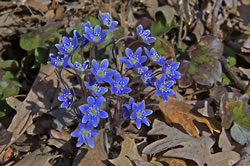USDA Forest Service Celebrating Wildflowers
|
|
|
Plant of the Week
Hepatica (Hepatica nobilis)By David Pivorunas Searching for the first wildflowers of the year is one of the highlights of early spring. In eastern North America, one of the most delightful early blooming species is hepatica (Hepatica nobilis). Its bright blue, white, or pink flowers warm the hearts of all who see them, as they shimmer in the rays of sunshine that reaches the forest floor thru the branches of the leafless trees of earliest springtime. The flowers may not fully open on a rainy day but even on cloudy days it is still quite a thrill to come across the subtle elegance of the partially opened flowers heralding the opening of the new season. The flowers have a fresh, delicate scent, their fragrance promises that spring is just around the corner. Hepatica nobilis is a small evergreen herb found growing in rich woodlands from Minnesota to Maine to Northern Florida west to Alabama. The flowers are most commonly blue or lavender, although white forms may be common locally, especially in southern areas, and there may be various shades of pink. Each flower comes up from the ground on its own stem, which is covered by long fine hairs and is several inches tall. What appear to be the petals are technically the sepals and three bracts surround each flower. The number of sepals on each flower usually varies between six and twenty. Occasionally, complete double forms are found. Older plant form clumps with twenty to thirty or more flowers. The flowers open their fullest on sunny days and the floral display lasts for several weeks. After the petals fall the new leaves emerge, each one at first neatly furled, then shiny and bright fresh green as they first open, then darkening as they mature. The leaves are heart shaped at the base and have three lobes. Some variations of the species may have speckled leaves or may be maroon on the undersides. Over the winter, the leaves darken even more and are hardly noticeable. Hepatica nobilis occurs in eastern North America, Europe, and Japan. Variety obtusa and var. acuta occur in North America, var. nobilis and pyrenaica in Europe and var. asiatica, var. japonica and var. pubescens in Japan. In addition, several other hepatica species occur in Europe and the Far East. Sometimes the two North American varieties are considered to be species in their own rite. The synonym for var. obtusa is Hepatica Americana, and for var. acuta is Hepatica acutiloba. They are very similar in appearance except that the lobes on the leaves of var. obtusa are blunt and those on var. acuta come to a point. Hepatica nobilis var. obtusa is often found on more acid soils while var. acuta is most common on calcareous soils. Hepatica nobilis also occurs in Europe from England across Scandinavia thru the Baltic States, east to Ukraine, and south to Italy and Spain. In other areas, it is still frequently encountered. The flower is one of the most beloved wildflowers in Lithuania, where it is represented in folklore and motifs and is called “zibute” or “zibuokle”, a reference to the sparking shine of the colorful flower, which is especially noticeable in the dull, drab grays, and browns of the early spring woods. Flowers of the European forms of Hepatica nobilis are usually a bright dark blue and reminiscent of the clear blue skies of spring. Hepatica nobilis makes a lovely garden plant for shaded location with rich organic soils. Once established in a good location they will live for many years. They form colorful little clumps of flowers that will bloom with some of the first spring flowers such as the crocus. In Europe and Japan, where there are many named cultivars, it is more common to find them in the garden than in the United States. Some of the rare Japanese named varieties can also be obtained from mail order nurseries, but they may be very expensive as they are rare and propagated by division. There is a nice double dark pink selection originally from Europe, which is sometimes available commercially in the United States. The two American forms of the species can be purchased from wildflower nurseries. For More Information: PLANTS Profile - Hepatica nobilis, Hepatica |
|
| NOTE: PDF format links require the Adobe Acrobat Reader to view. | |
| top | Disclaimers | FOIA | Privacy Policy | Quality of Information | Photo Credits & Use |
Location: http://www.fs.fed.us/wildflowers/plant-of-the-week/hepatica_nobilis.shtml
Last modified: Thursday, 09-Apr-2009 15:41:59 EDT










